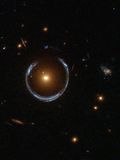Astronomers Discover Potentially Largest Black Hole Yet

A team of astronomers has identified a potential new supermassive black hole with an estimated mass of 36 billion times that of the Sun. This remarkable discovery positions it as approximately 10,000 times heavier than the black hole at the center of the Milky Way Galaxy, making it one of the most massive objects ever detected. The findings, published in the Monthly Notices of the Royal Astronomical Society, stem from research conducted by the Institute of Cosmology and Gravitation at the University of Portsmouth in the UK, in collaboration with the Federal University of Rio Grande in Brazil.
The newly identified black hole resides within a gravitational lens known as the Cosmic Horseshoe. A gravitational lens occurs when the immense gravity of a massive object, such as a galaxy, bends light from objects situated behind it, creating a distorted visual effect. Discovered by the Hubble Space Telescope in 2007, the Cosmic Horseshoe features a bright blue horseshoe shape surrounding the yellow galaxy LRG 3-757. This galaxy is one of the most massive ever observed, with a mass approximately 100 times that of the Milky Way and located around 5.6 billion light-years from Earth.
Utilizing this gravitational lens, astronomers have been able to estimate the mass of the black hole presumed to be at the center of LRG 3-757. While there are no direct observations of this black hole, the movement of light in the surrounding ring and the velocity of stars in the galaxy’s inner regions support the existence of an ultramassive black hole.
Thomas Collett, a professor of astrophysics at the University of Portsmouth, stated, “By combining these two measurements we can be completely confident that the black hole is real.” He further suggested that a black hole of this size likely formed from the merger of two supermassive black holes resulting from galaxy collisions. This notion raises intriguing questions about the fate of our own Milky Way Galaxy and its neighboring Andromeda.
Currently, the largest known black hole is potentially TON 618, which is estimated to have a mass equivalent to 66 billion suns. This figure is nearly twice that of the black hole associated with the Cosmic Horseshoe. Nevertheless, scientists exercise caution in labeling TON 618 as the most massive object observed. Located more than 10 billion light-years away, its host galaxy and surrounding features remain poorly understood. Insights into TON 618’s characteristics are primarily derived from brightness analysis and theoretical models, leading to significant uncertainties regarding its size.
In contrast, the research team at Portsmouth argues that the Cosmic Horseshoe black hole offers greater observational clarity compared to more distant, less well-defined objects like TON 618. They assert that their discovery may represent the most massive black hole confirmed to date, providing a rare opportunity for further exploration of these enigmatic cosmic phenomena. This discovery not only enhances our understanding of black hole formation but also contributes to the broader discourse about the evolution of galaxies in the universe.






